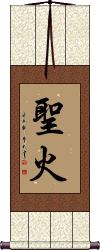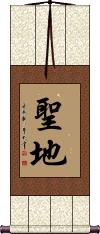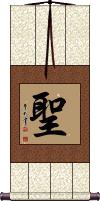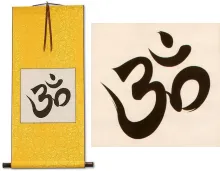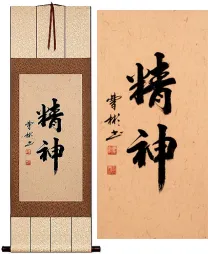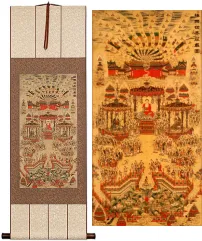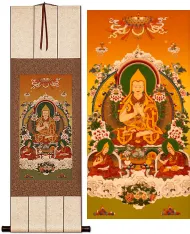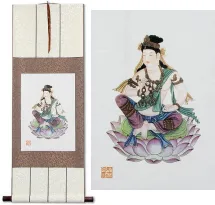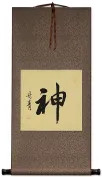Many custom options...
And formats...

Sacred in Chinese / Japanese...
Buy a Sacred calligraphy wall scroll here!
Personalize your custom “Sacred” project by clicking the button next to your favorite “Sacred” title below...
Sacred Fire
聖火 is a Chinese, Japanese and Korean term that applies to the sacred fire of the ancient Greek Olympic torch or games.
This could also apply to other sacred or holy fires, as it can be a somewhat generic term.
Holy Land
聖地 can be titled or translated in a lot of different ways: sacred ground, the Holy Land, Holy city, sacred place, Holy ground, or shrine.
I have seen all of these English translations used when coming from Chinese, Japanese, and Korean.
The Saint
聖 is the simple, single-character religious form of “saint” in Chinese (also holds the same meaning in Japanese and Korean, though rarely used alone like this).
This can also mean holy, sage, master, or priest.
Note: 聖 is often used in compound words (words of more than one character) to create further meanings. In compounds, it can mean holy, sacred, or divine.
聖 is also used as the first word for Spanish and English place names such as “San Diego” and “St. Louis” in Chinese (not Japanese).
In the Buddhist context, this can represent ārya or sādhu. And mean a sage; wise and good; upright, or correct in all his character; sacred, holy, or saintly.
This in-stock artwork might be what you are looking for, and ships right away...
Gallery Price: $72.00
Your Price: $39.88
Starting at: $28.88
Starting at: $28.88
Gallery Price: $108.00
Your Price: $59.88
Gallery Price: $150.00
Your Price: $82.88
Gallery Price: $108.00
Your Price: $59.88
Gallery Price: $90.00
Your Price: $49.88
Gallery Price: $90.00
Your Price: $49.88
Gallery Price: $72.00
Your Price: $39.88
Gallery Price: $101.00
Your Price: $55.88
Gallery Price: $63.00
Your Price: $34.88
Gallery Price: $63.00
Your Price: $34.88
Not the results for sacred that you were looking for?
Below are some entries from our dictionary that may match your sacred search...
| Characters If shown, 2nd row is Simp. Chinese |
Pronunciation Romanization |
Simple Dictionary Definition |
聖 圣 see styles |
shèng sheng4 sheng hijiri ひじり |
More info & calligraphy: The Saint(1) highly virtuous monk; (2) (honorific or respectful language) monk; (3) Buddhist solitary; (4) (See 高野聖・1) Buddhist missionary; (5) saint (i.e. a virtuous person); (6) (archaism) (honorific or respectful language) emperor; (7) (in form 〜の聖) master; expert; (female given name) Mina ārya; sādhu; a sage; wise and good; upright, or correct in all his character; sacred, holy, saintly. |
蓮 莲 see styles |
lián lian2 lien ren れん |
More info & calligraphy: Lotus(out-dated or obsolete kana usage) (1) (kana only) sacred lotus (Nelumbo nucifera); Indian lotus; lotus; (2) rose of Sharon (Hibiscus syriacus); (kana only) sacred lotus (Nelumbo nucifera); Indian lotus; lotus; (f,m,s) Ren puṇḍarīka, the lotus, especially the white lotus, Numphoea alba; padma, especially the Nelumbium speciosum; utpala, the Nymphoea coerulea, the blue lotus; kumuda, Nymphoea esculenta, white lotus, or N. rubra, red lotus; nīlotpala, N. cyanea, a blue lotus. The first four are called white, red, blue, and yellow lotuses; but the white lotus is generally meant unless otherwise specified. |
吠陀 see styles |
fèi tuó fei4 tuo2 fei t`o fei to Beida ヴェーダ |
More info & calligraphy: Veda(kana only) Veda (san:) Veda, v. 韋. |
泰山 see styles |
tài shān tai4 shan1 t`ai shan tai shan yasuyama やすやま |
More info & calligraphy: Tarzanlarge mountain; Mt Taishan (China); (surname) Yasuyama Tai Shan in Shandong, the eastern sacred mountain of China. |
聖地 圣地 see styles |
shèng dì sheng4 di4 sheng ti seichi / sechi せいち |
More info & calligraphy: Holy Land(1) sacred place; holy ground; the Holy Land; (2) (slang) real-life location used as a setting in a novel, film, anime, etc.; (place-name) Seichi stage of enlightenment |
聖火 圣火 see styles |
shèng huǒ sheng4 huo3 sheng huo seika / seka せいか |
More info & calligraphy: Sacred Fire(1) sacred fire; sacred flame; (2) (See オリンピック聖火) Olympic flame; Olympic torch; (given name) Seika |
聖職 圣职 see styles |
shèng zhí sheng4 zhi2 sheng chih seishoku / seshoku せいしょく |
More info & calligraphy: Ministry / Priesthood(noun - becomes adjective with の) sacred profession; holy orders; vocation; ministry |
貴い see styles |
toutoi / totoi とうとい tattoi たっとい |
More info & calligraphy: Precious |
菩提樹 菩提树 see styles |
pú tí shù pu2 ti2 shu4 p`u t`i shu pu ti shu bodaiju; bodaiju ぼだいじゅ; ボダイジュ |
More info & calligraphy: The Tree of Enlightenment / The Bodhi Tree(1) Tilia miqueliana (species of linden tree); (2) (See インドボダイジュ) sacred fig (Ficus religiosa); bodhi tree; bo tree; peepal tree; pipal tree; (given name) Bodaiju bodhidruma, bodhitaru, bodhivṛkṣa; the wisdom-tree, i.e. that under which Śākyamuni attained his enlightenment, and became Buddha. The Ficus religiosa is the pippala, or aśvattha, wrongly identified by Faxian as the palm-tree; it is described as an evergreen, to have been 400 feet high, been cut down several times, but in the Tang dynasty still to be 40 or 50 feet high. A branch of it is said to have been sent by Aśoka to Ceylon, from which sprang the celebrated Bo-tree still flourishing there. |
道德經 道德经 see styles |
dào dé jīng dao4 de2 jing1 tao te ching Dōtoku kyō |
More info & calligraphy: Daodejing / Tao Te ChingDaode jing |
一言九鼎 see styles |
yī yán jiǔ dǐng yi1 yan2 jiu3 ding3 i yen chiu ting |
More info & calligraphy: Words Have Enormous Weight: One Word Worth Nine Caldrons |
卍 see styles |
wàn wan4 wan manji まんじ |
swastika, a sacred and auspicious symbol in Hinduism, Buddhism, and Jainism swastika (esp. a counterclockwise swastika as a Buddhist symbol); fylfot; gammadion; (given name) Manji sauvastika, 塞縛悉底迦; also styled 室利靺瑳 śrīvatsa, lucky sign, Viṣṇu's breast-curl or mark, tr. by 海雲 sea-cloud, or cirrhus. Used as a fancy form of 萬 or 萬; and is also written in a form said to resemble a curl. It is the 4th of the auspicious signs in the footprint of Buddha, and is a mystic diagram of great antiquity. To be distinguished from 卐svastika, the crampons of which turn to the right. |
卐 see styles |
wàn wan4 wan man |
swastika, a sacred and auspicious symbol in Hinduism, Buddhism, and Jainism, later adopted by Nazi Germany (Skt. svastika) |
塔 see styles |
tǎ ta3 t`a ta tou / to とう |
pagoda (abbr. of 塔婆[ta3po2], a loanword from Sanskrit stūpa); tower; pylon (CL:座[zuo4]); (loanword) (pastry) tart (n,n-suf) (1) tower; steeple; spire; (2) (abbreviation) (original meaning) (See 卒塔婆・1,塔婆・1) stupa; pagoda; dagoba; (surname) Tousaki stūpa; tope; a tumulus, or mound, for the bones, or remains of the dead, or for other sacred relics, especially of the Buddha, whether relics of the body or the mind, e.g. bones or scriptures. As the body is supposed to consist of 84,000 atoms, Aśoka is said to have built 84,000 stūpas to preserve relics of Śākyamuni. Pagodas, dagobas, or towers with an odd number of stories are used in China for the purpose of controlling the geomantic influences of a neighbourbood. Also 塔婆; 兜婆; 偸婆; 藪斗波; 窣堵波; 率都婆; 素覩波; 私鍮簸, etc. The stūpas erected over relics of the Buddha vary from the four at his birthplace, the scene of his enlightenment, of his first sermon, and of his death, to the 84,000 accredited to Aśoka. |
梵 see styles |
fàn fan4 fan bon ぼん |
abbr. for 梵教[Fan4 jiao4] Brahmanism; abbr. for Sanskrit 梵語|梵语[Fan4 yu3] or 梵文[Fan4 wen2]; abbr. for 梵蒂岡|梵蒂冈[Fan4 di4 gang1], the Vatican (1) Brahman (ultimate reality of the universe in Hinduism); Brahma; (2) Brahma (Hindu creator god); (3) (abbreviation) (See 梵語) Sanskrit; (given name) Bon Brahman (from roots bṛh, vṛh, connected with bṛṃh, "religious devotion," "prayer," "a sacred text," or mantra, "the mystic syllable om"; "sacred learning," "the religious life," "the Supreme Being regarded as impersonal," "the Absolute," "the priestly or sacerdotal class," etc. M.W. Translit. |
榊 see styles |
shén shen2 shen tachibana たちばな |
(Japanese kokuji) sakaki (Cleyera japonica), evergreen tree used in Shinto to decorate sacred spaces (1) sakaki (species of evergreen sacred to Shinto, Cleyera japonica); (2) evergreen (esp. one planted or used at a shrine); (personal name) Tachibana |
經 经 see styles |
jīng jing1 ching tsune つね |
classics; sacred book; scripture; to pass through; to undergo; to bear; to endure; warp (textile); longitude; menstruation; channel (TCM); abbr. for economics 經濟|经济[jing1 ji4] (female given name) Tsune A warp, that which runs lengthwise; to pass through or by, past; to manage, regulate; laws, canons, classics. Skt. sūtras; threads, threaded together, classical works. Also called 契經 and 經本. The sūtras in the Tripiṭaka are the sermons attributed to the Buddha; the other two divisions are 律 the Vinaya, and 論 the śāstras, or Abhidharma; cf. 三藏. Every sūtra begins with the words 如是我聞 'Thus did I hear', indicating that it contains the words of Śākyamuni. |
藕 see styles |
ǒu ou3 ou gō はす |
root of lotus (kana only) sacred lotus (Nelumbo nucifera); Indian lotus; lotus The water-lily root, arrowroot. |
おん see styles |
on おん |
(from 拝み) (See 御嶽・うたき) (Okinawa) sacred site; sacred grove; (female given name) On; On-TV |
七僧 see styles |
qī sēng qi1 seng1 ch`i seng chi seng shichisō |
A monastery is supposed to possess the following seven monks: 咒願師 invoker; 導師 leader; 唄師 intoner, or leader of the chanting; 散花師 flower-scatterer; 梵音師 master of sacred words, or Sanskrit; 錫杖師 shaker of the rings on the metal staff, or crozier; 堂達 distributor of missals, etc. Another division is 講師 expounder; 讀師 reader; 咒願師; 三禮師 director of the three ceremonies; 唄師; 散花師; and 堂達. |
七聖 七圣 see styles |
qī shèng qi1 sheng4 ch`i sheng chi sheng nanasei / nanase ななせい |
(male given name) Nanasei v.七賢, 七聖, 七聖財, saptadhana. The seven sacred graces variously defined, e.g. 信 faith, 戒 observation of the commandments, 聞hearing instruction, 慙 shame (for self), 愧 shame (for others); 捨 renunciation; and慧 wisdom. |
三緣 三缘 see styles |
sān yuán san1 yuan2 san yüan sanen |
The three nidānas or links with the Buddha resulting from calling upon him, a term of the Pure Land sect: (a) 親緣 that he hears those who call his name, sees their worship, knows their hearts and is one with them; (b) 近緣 that he shows himself to those who desire to see him; (c) 增上緣 that at every invocation aeons of sin are blotted out, and he and his sacred host receive such a disciple at death. |
中嶽 中岳 see styles |
zhōng yuè zhong1 yue4 chung yüeh nakatake なかたけ |
Mt Song 嵩山 in Henan, one of the Five Sacred Mountains 五嶽|五岳[Wu3 yue4] (surname) Nakatake |
五山 see styles |
wǔ shān wu3 shan1 wu shan gosan; gozan ごさん; ござん |
(rare) five most important temples of a region; (surname) Goyama Five mountains and monasteries: (1) in India, sacred because of their connection with the Buddha: 鞞婆羅跋怒 Vaibhāra-vana; 薩多般那求呵 Saptaparṇaguhā; 因陀羅勢羅求呵 Indraśailaguhā; 薩簸恕魂直迦鉢婆羅 Sarpiṣ kuṇḍikā-prāgbhāra; 耆闍崛 Gṛdhrakūṭa; (2) in China, established during the Five Dynasties and the Southern Sung dynasty, on the analogy of those in India; three at Hangzhou at 徑山 Jingshan, 北山 Beishan, and 南山 Nanshan and two at Ningbo at 阿育王山 King Aśoka Shan and 太白山 Taiboshan. Later the Yuan dynasty established one at 全陵 Chin Ling, the 天界大龍翔隻慶寺 which became chief of these under the Ming dynasty. |
五嶽 五岳 see styles |
wǔ yuè wu3 yue4 wu yüeh |
Five Sacred Mountains of the Daoists, namely: Mt Tai 泰山[Tai4 Shan1] in Shandong, Mt Hua 華山|华山[Hua4 Shan1] in Shaanxi, Mt Heng 衡山[Heng2 Shan1] in Hunan, Mt Heng 恆山|恒山[Heng2 Shan1] in Shanxi, Mt Song 嵩山[Song1 Shan1] in Henan See: 五岳 |
仏跡 see styles |
busseki ぶっせき |
place sacred to Buddhism |
佛骨 see styles |
fó gǔ fo2 gu3 fo ku bukkotsu |
Buddha's bones (as a sacred relic) A bone of the Buddha, especially the bone against whose reception by the emperor Xianzong the famous protest of Hanyu was made in 819. |
侍聖 侍圣 see styles |
shì shèng shi4 sheng4 shih sheng shishō |
Sacred Monk's acolyte |
出聖 出圣 see styles |
chū shèng chu1 sheng4 ch`u sheng chu sheng shusshō |
The surpassing sacred truth, or the sacred immortal truth. |
制多 see styles |
zhì duō zhi4 duo1 chih to seita / seta せいた |
(personal name) Seita 制底 (or 質底); 制體 caitya, a tumulus, mausoleum, monastery, temple, spire, flagstaff on a pagoda, sacred place or thing, idem 支提 (or 支帝), cf. 刹. |
Click here for more sacred results from our dictionary
The following table may be helpful for those studying Chinese or Japanese...
| Title | Characters | Romaji (Romanized Japanese) | Various forms of Romanized Chinese | |
| Sacred Fire | 聖火 圣火 | seika | shèng huǒ sheng4 huo3 sheng huo shenghuo | |
| Holy Land | 聖地 圣地 | seichi | shèng dì / sheng4 di4 / sheng di / shengdi | sheng ti / shengti |
| The Saint | 聖 圣 | sei | shèng / sheng4 / sheng | |
| In some entries above you will see that characters have different versions above and below a line. In these cases, the characters above the line are Traditional Chinese, while the ones below are Simplified Chinese. | ||||
Successful Chinese Character and Japanese Kanji calligraphy searches within the last few hours...
